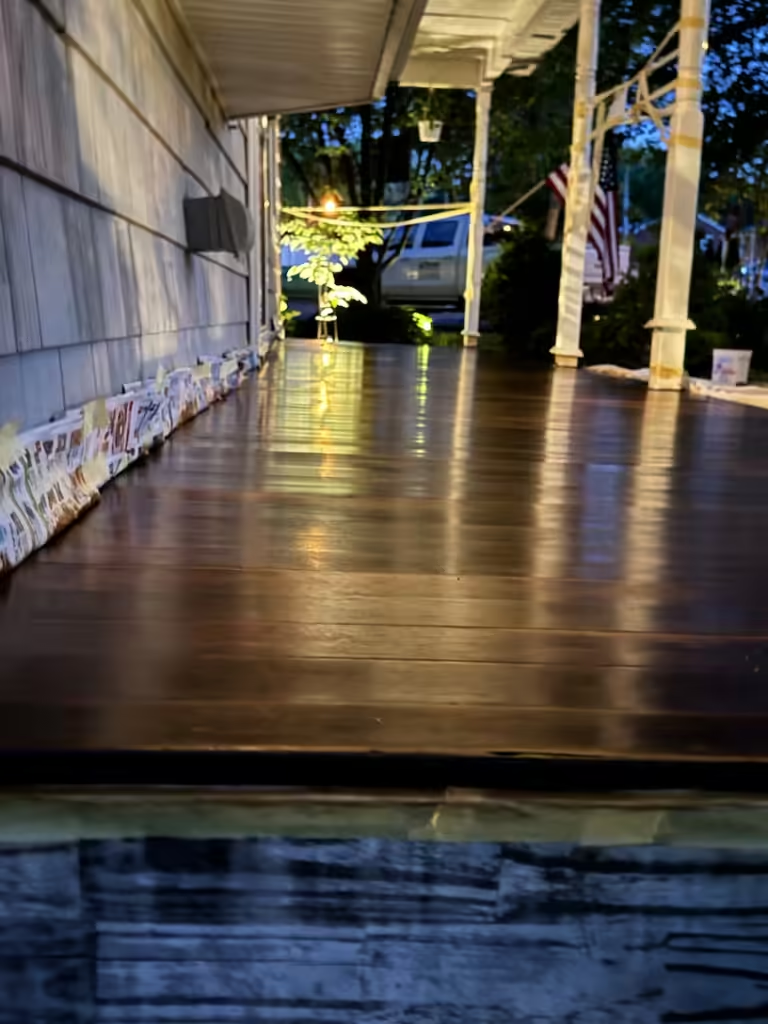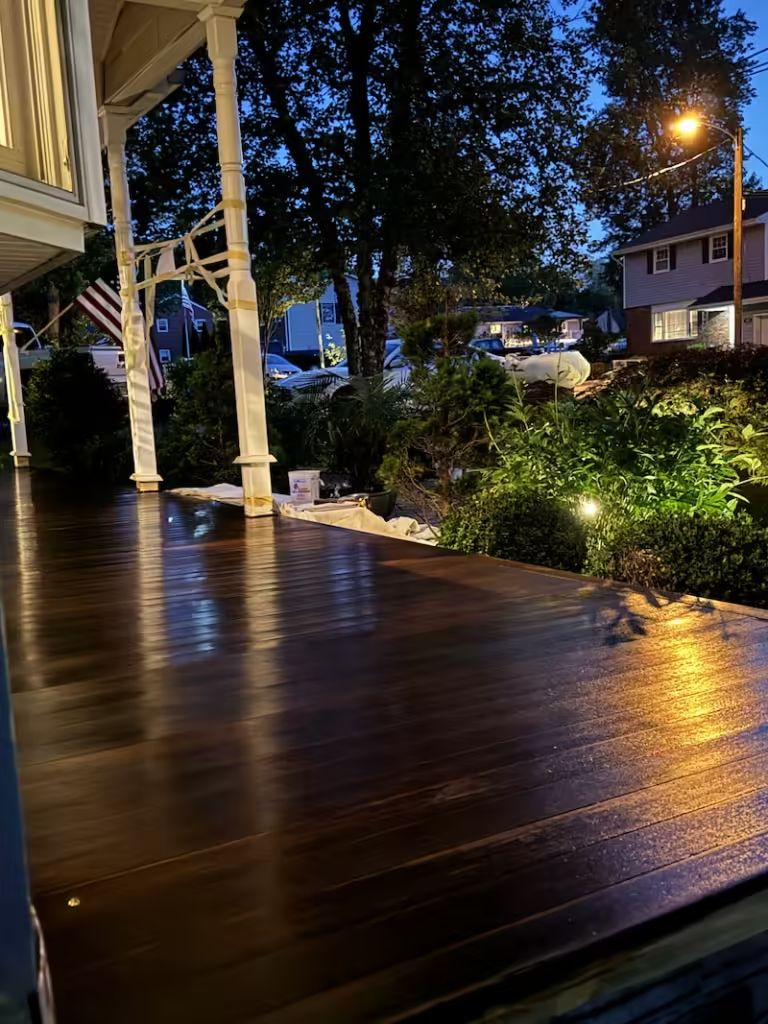Introduction
Imagine you’re ready to refresh your porch. You’ve chosen a beautiful Cabot Gold finish. Brush in hand, you’re set to start. Suddenly, the weather changes, and rain is due. Your plans and heart both drop.
I’ve faced this challenge, skipping the weather check. One summer, the stain dried too fast in the intense sun. In early spring, rain spoiled my freshly stained porch, leaving uneven spots.
The right timing, or should I say seasonal considerations for staining, is crucial for staining your porch. Aim for a period with temperatures between 50 and 90°F and no rain expected. Late spring and early fall are usually the best times. This ensures the stain dries well and lasts longer.
Key Takeaways
- Watch the Weather: Choose the best time for porch work.
- Optimal Temperature: Stain when it’s 50-90°F. I was riding on the line last week at 85, when it was supposed to be in the mid-high 70’s.
- Avoid Humidity: Don’t stain when it’s rainy or very humid.
- Best Seasons: Late spring and early fall are best for staining.
- Quality Stain: A top-notch stain like the Cabot Gold, which I recently used, yields great results.
Understanding the Best Time to Stain Your Porch
If you’re like me, you might wonder about the best time to stain your porch. It’s a common question. The secret is, timing is everything. It can save you time, money, and avoid frustration.
Temperature Impact
Stain absorption varies greatly with it. Cool, dry seasons boost absorption by up to 20% more than hot, humid ones. It also dries faster when it’s above 80 degrees but takes longer to cure (harden), which is, unfortunately, another thing I learned last week. You really don’t want your stain job to end up uneven. I’ve experienced that mess myself—it’s not fun.
Humidity
High humidity is your enemy here. Stains don’t set well in damp conditions, leading to a 30% increase in issues. And drying times? They drag on forever, much like a Game of Thrones marathon.
Durability
For durability, think timing. Stain your porch in mid to late spring or early fall. These seasons can extend your stain’s life by 15%, unlike the unpredictable summer. Plus, you get 25% more protection from the sun. That means less color fading.
Aesthetics
Looks matter too. Porches stained in better conditions get a better result, hands down. A beautifully stained porch can make your neighbors just a bit jealous.
Summary: Managing humidity, drying times, and weather considerations is crucial. Stay away from staining in high humidity and extreme temps. Instead, aim for those ideal periods in spring and fall. Smart planning makes all the difference. Your porch will be better for it!

The Importance of Seasonal Staining
When staining, timing is crucial. It’s not just about porch longevity but also avoiding unnecessary problems. I’ve seen it firsthand. A porch peels after a single season if you don’t mind the humidity effect on stain.
Temperature Control
So, what’s the trick? Focus on the temperature impacting stain application. Aim for weather that’s not too hot or cold, ideally between 50°F and 90°F. Though many think summer is perfect, 33% regret it. High temperatures make the stain dry unevenly.
Humidity Matters
Humidity is equally important. Too much makes drying slow and leaves your porch sticky. It catches leaves and dust, which is not what anyone wants. Choose days with low humidity and no rain coming. This helps the stain adhere better. If you are using Cabot Gold, it’s super important that it does not rain 24 hours before and after the stain goes on and this particular stain is best with 2 coats. To me, it is worth it though because it’s beautiful!
Optimal Seasons
Around 48% of homeowners choose to stain in the fall. It offers stable temperatures, low humidity, and fewer weather issues. It’s perfect for showcasing a fresh porch at holiday events.
Summary: Knowing when to stain is key. Right temperatures and low humidity, along with tips from here, ensure a beautiful and durable porch.
Essential Preparation Steps for Staining
Before you start, know that good preparation is key. Your deck might look tough, but it needs careful preparation for staining. This ensures the stain soaks in well and lasts a long time.
Cleaning
Start with a good deck cleaning. Dirty decks won’t take stain well, ending up looking bad. Clean off grime, tannins, mill glaze, and hidden dirt. It’s like giving your deck a much-needed spa day, complete with a wash!
Moisture Check
Check for moisture in the wood. It must be completely dry before staining. Sometimes, new wood needs to sit for three months. This wait makes sure it’s ready to look its best.
Taping
Get your hands on Frog Tape. It’s your precision tool in this painting adventure. Frog Tape ensures you only stain the right spots. It’s highly rated by thousands of users.
Weather Consideration
Also, think about the weather. Avoid extreme heat or impending rain for the best results. Look for mild, dry days. This perfect weather helps your staining job stand out.
Summary: Thorough cleaning, using Frog Tape, and checking the wood’s condition are crucial steps. These preparations ensure your stain endures many seasons. Your deck will definitely appreciate the effort.
How Weather Conditions Impact Staining
Weather plays a big part in porch staining projects. Bad weather, like rain or extreme heat, can mess up your work. High heat speeds up stain drying, which might cause an uneven finish. Cold weather, though, can make the stain dry too slowly. This makes it hard for the stain to soak into the wood. Spending lots of time only to have weather spoil your efforts is frustrating.

High Humidity
High humidity can also spoil your staining day. It makes the wood take in too much stain, leading to patches. Also, it takes longer for the stain to dry in humid weather. This could let moisture damage the fresh stain. So, knowing how the weather affects your staining work can keep you from getting upset and wasting your time.
Sun Exposure
Too much sun can fade the color of your stain over time. If your porch gets a lot of sun, you might have to stain it more often. In wet places, you’ll likely stain even more frequently than in dry areas. About half of the staining jobs in bad weather get delayed. And fixing weather-damaged stained porches can get very costly.

